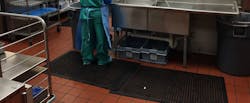Q
“In my department, we use anti-fatigue mats that do not have holes in them. A surveyor just cited us and stated anti-fatigue mats require holes in them. Is this true?”
A
The Occupational Safety and Health Administration (OSHA) does not have regulations or standards specifically for anti-fatigue mats, but in its Ergonomics publication, the government body recommends their use for employees who need to work in uncomfortable positions. That basic description fits the work we do in the decontamination area—"uncomfortable.”
We know that OSHA mandates that workplaces have clean floors, and American National Standards Institute (ANSI) issued regulations in 2001 about updating floor standard systems with mats. The organization issued the standard ANSI/ASSEA 1264.2-2001 Provision of Slip Resistance on Walking/Working Surfaces. These standards detail ways to create and maintain work surfaces and reduce falls. To my knowledge, having holes or not having holes [in mats] is not specified.
Here are a few suggestions for picking anti-fatigue floor mats:
- Know the purpose of the mat.
o Anti-slip or other mats are different from anti-fatigue mats.
o Choose a mat that matches your needs best (might be different for different areas of the department).
- Select the correct thickness of the mat.
o Softer and thicker may not always be better.
o Choose a mat that provides some elasticity.
o Overly soft mats may cause standing discomfort.
- Measure the area for the correct size where the mat will be used.
o Decontamination area (usually in front of the sink area).
o Assembly area (usually in front of the workstation).
- Know the environment the mat will be used in.
o Mats should not slip or create a trip hazard.
o Mats should have sloped edges (less of a trip hazard and allows carts to roll over them more easily).
- Mats may need to be cleaned.
o Being able to adequately clean mats is important.
o Can it be cleaned by being placed in a medical cart washer?
o What chemicals can be used on the surface for cleaning?
o Set up a schedule to clean them and under them (the floor).
Concerning the statement that the surveyor made about anti-fatigue mats require having holes, you (as a customer of the surveying organization) have the right to ask the surveying body where they are quoting a standard or guideline from and to share that information with you to see if you are compliant or even following that guidance/guideline document. Surveying organizations do not make standards or guidelines. You have a right to challenge the surveyor (in a positive way).
Here is how I might word my reply.
“Since the Occupational Safety and Health Administration (OSHA) does not have regulations or standards specifically for anti-fatigue mats, the type of mats we have chosen for our staff provide the proper safety requirements for the task they perform and within the area they are working in. We respectfully ask that [the name of the surveying organization] to please share with us the specific standard or guidelines being referenced concerning our mats we have selected for our staff to use in our Sterile Processing Department (SPD) so that we can respond accordingly.”
Lastly, document the process you used to pick the mats you have and keep that on file. If anybody asks, you have your reasoning.
Q
“What is the difference between OSHA and NIOSH?”
A
The National Institute of Occupational Safety and Health (NIOSH)- This government agency was established as the research counterpart to OSHA. NIOSH activities include testing and certifying respirators and conducting research and investigations on the health effects of occupational exposures.
The U.S. Occupational Safety and Health Administration (OSHA)- This agency was established to promulgate and enforce workplace health and safety standards.
References:
1. Scott, Gillian. (2019). A Guide for Prolonged Standing at Work: Anti-Fatigue Mats. MSC Industrial Direct Co., Inc. https://www.mscdirect.com/betterMRO/safety/guide-prolonged-standing-work-anti-fatigue-mats.
2. Dixon-Roderick, P. (2015). [Memo to Kyle Sullivan, Senior manager of Environmental, Health, and Safety Governance; Amazon NAFC]. United States Department of Labor/Occupational Safety and Health Administration (OSHA). https://www.osha.gov/ooc/citations/Amazon_1074833_eHAL.pdf.
3. XpressMats. (n.d.). Safety Laws by OSHA and ANSI formats. XpressMats. https://www.xpressmats.com/safety-laws-osha-ansi-mats.
4. NoTrax. (n.d.). Floor Safety OSHA Regulations: A Guide to Avoiding Injury and Lost Productivity. NoTrax. https://notrax.justrite.com/buyers-guide/injury.
About the Author

Stephen M. Kovach
Stephen M Kovach, BS, CFER, started in the medical field in 1975 as a sterilization orderly and has worked in many positions within the Healthcare Industry. He presently is Clinical Educator Emeritus at Healthmark, A Getinge company.


